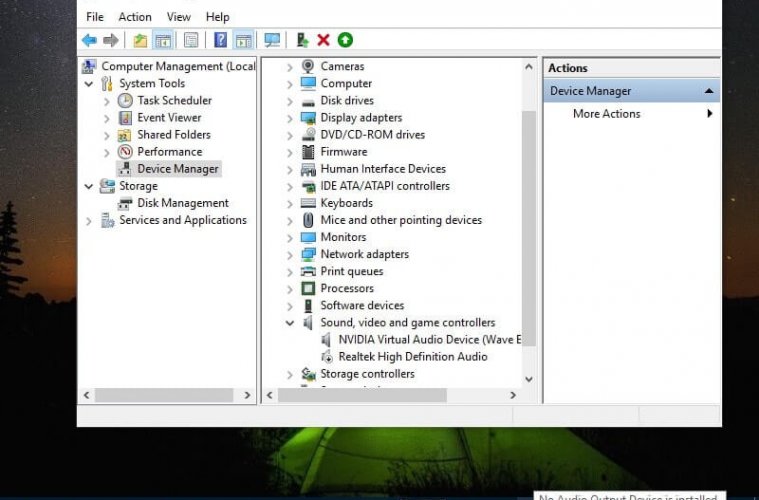

- #.NET AUDIODEVICE DRIVERS#
- #.NET AUDIODEVICE UPDATE#
- #.NET AUDIODEVICE SOFTWARE#
- #.NET AUDIODEVICE PC#
- #.NET AUDIODEVICE LICENSE#
Os.system('chmod 777 -R /home/pi/sounds') # Make sure that the 'sounds' folder exists, and if it does not, create it The built-in MEMS microphone on the Codec Zero is automatically disabled when the external Mic in connector is used.ĭate = datetime.now().strftime("%d_%m_%Y-%H:%M:%S") Ext micĪ 3.5mm socket for use with an external electret microphone. This can be used to feed audio into an amplifier at a reduced volume compared to Line out. Delivers analogue audio out up to 1V RMS. Aux outĪ double Phono/RCA connector or 3.5mm socket. This can be used to record audio from a variable analogue source such as a mobile phone, MP3 player or similar. Aux inĪ double Phono/RCA connector or 3.5mm socket. The headphone amplifiers on the Raspberry Pi DAC boards can drive up to 80/90Ω impedance headphones. HeadphonesĪ 3.5mm jack socket delivering stereo audio for a set of headphones. Mono speakerĪ screw terminal for a single 1.2W speaker, as found in a transistor radio or similar. These are for traditional hi-fi speakers without built-in amplification. Two sets of screw terminals for 2×25W speakers. Stage directed towards the DJ or performers. It can also be used to drive active monitor speakers like those used at clubs or on This is used in a studio set-up, and in some Balanced outĪn XLR connector, normally a three-pin male connector. To drive active speakers which have their own amplifier built in. This output is a variableĪnalogue signal (0-2V RMS) and can connect to your existing hi-fi (pre-amp or amplifier), or can be used
#.NET AUDIODEVICE DRIVERS#
stick to only the customized realtek audio drivers from ASRock (unless newer packages have been released that included the Creative DLL files).A double phono/RCA connector, normally red and white in colour.
#.NET AUDIODEVICE PC#
If those files are missing and/or not correctly registered with the Realtek audio drivers, the SBC3 program will not recognize the onboard Realtek audio chip.Īvoid using the Realtek audio drivers from Microsoft and from other PC manufacturers as most of the time, the Realtek drivers do not come with the Creative DLL files for sound blaster cinema 3. For x86 / 32bit Windows, the mbwrp32.dll & mbapo232.dll files should be installed in the Windows\System32 folder. The mbapo264.dll & mbwrp64.dll files should be installed in the Windows\System32 folder and the mbapo232.dll file should be installed in the Windows\Syswow64 folder (when using 圆4 editions of Windows). mbapo232.dll, mbapo264.dll, mbwrp64.dll > for 64bit Windows, mbwrp32.dll > for 32bit Windows).
#.NET AUDIODEVICE LICENSE#
No kga license file = no supported audio device for SBC3Īnd when the sound blaster cinema 3 program is installed these files should be in the Windows folder:Īny one of those files missing or corrupted will cause the SBC3 program to fail with "no supported audio device available" message.Īlso remember that the Realtek drivers installed MUST include the Creative audio integration DLL files (ex.
#.NET AUDIODEVICE SOFTWARE#
Only a valid kga license file will allow running SBCinema3 on that particular computer as it is uniquely generated by the software and cannot be used/transferred to another computer.

There should only be ONE kga activation file (and maybe ONE dat file) for the Sound blaster cinema 3 software to work. Without those files, the Sound Blaster Cinema 3 program will not work.Įdit 2/22: also folks, please check the following folder in Windows Explorer (set Windows Explorer or File Explorer to display all hidden & system files):
#.NET AUDIODEVICE UPDATE#
Note: do NOT use the new Realtek audio drivers like "ver 8210" or the newly released "ver 8308" from ASRock or any new Realtek audio driver packages from Windows Update or the Microsoft Update Catalog site as they do NOT contain the Creative audio integration DLL files (mbapo232.dll & mbapo264.dll). I'm wondering what version of Windows are you using when you had the problem? NET runtime files for Windows that needed to be regenerated using "ngen.exe update /force" command (under Win7, Win8.x & Win10) for the SBCinema3 program to correctly detect your Realtek audio device.

It looks like the Sound Blaster Cinema 3 software either had trouble recognizing your audio device due to either missing Creative audio integration files (mainly the MBAPO232.dll and MBAPO264.dll files - these should be in the WIN64 folder of the Realtek audio driver packages from 80), or some missing. driver for your Asrock Fatal1ty X370 Professional Gaming board that ASRock released on Januthat should also work with the Sound Blaster Cinema 3 software.


 0 kommentar(er)
0 kommentar(er)
